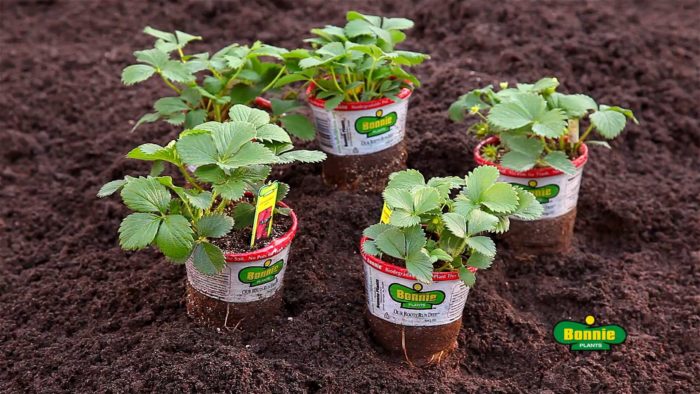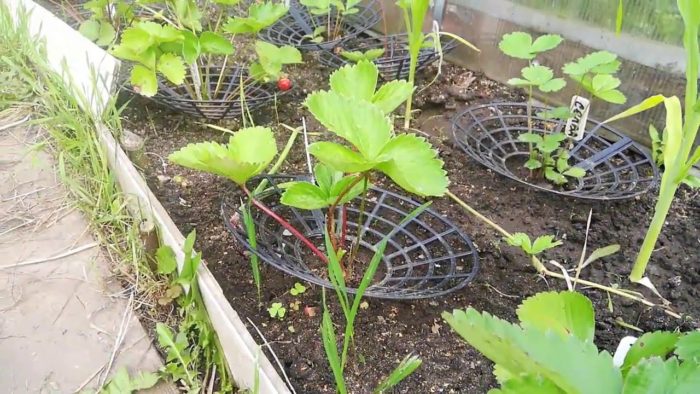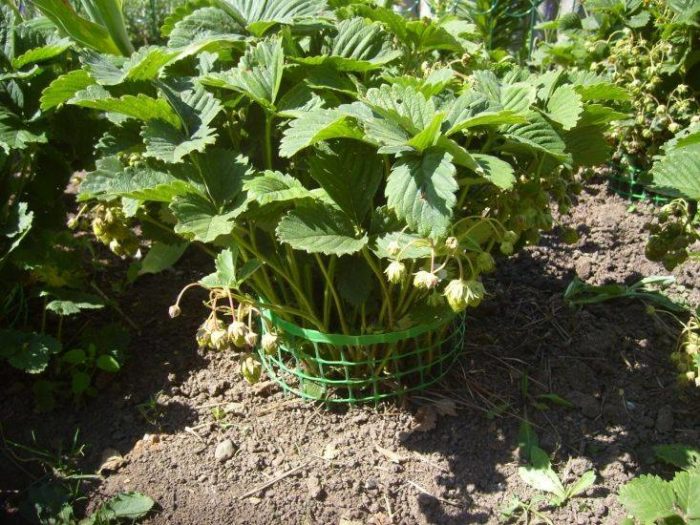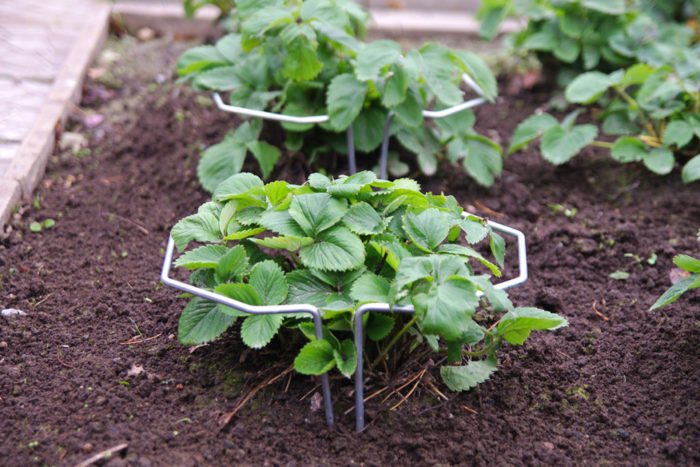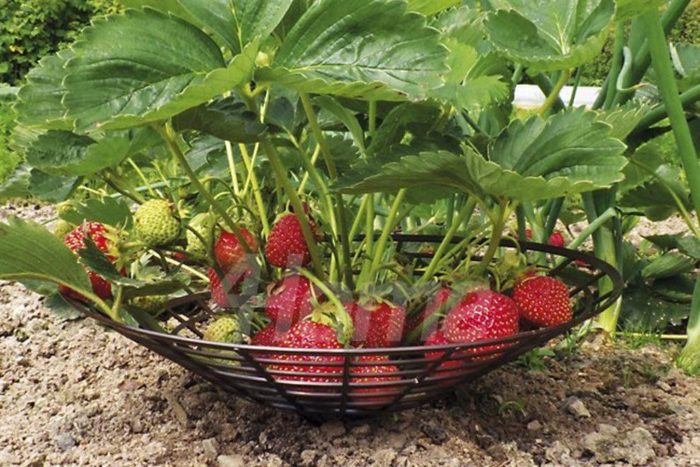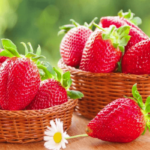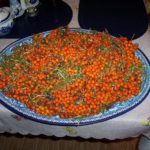When strawberries begin to bear fruit, their berries may lean toward the soil under their own weight. So they get dirty, rot and become prey for insects. To preserve a sweet harvest, gardeners are looking for various ways to protect strawberries from contact with the ground. Let's look at such devices for ripe strawberries so that the berries do not lie on the ground.
- Methods for gartering strawberries so they don't lie on the ground
- Making your own strawberry jigs
- Using Berry Liners
- Application of plastic forks
- Using Bent Wire
- Application of black covering material
- Ready-made strawberry tools available for purchase
- Using Grids
- Installing vertical supports for each strawberry bush
- Types of mulch to prevent strawberries from contacting the ground
- Organic mulch: using straw
- Inorganic mulch: using PVC film
- Additional options for growing strawberries
- Growing strawberries in pots
- Green wall: planting strawberries in modules
- Common mistakes
Methods for gartering strawberries so they don't lie on the ground
When berries lie on the ground, they are susceptible to many diseases. Most often, strawberries are affected by rot. After irrigation, the soil under strawberries can remain moist for a long time, especially in cloudy weather. Affected fruits cannot be saved.
In addition, it is difficult to wash the berries from the soil without damage due to the fact that they are porous and soft. And if the fruits become deformed during washing, this significantly reduces their shelf life.
In addition to rot and soil, berries pressed to the ground are subject to attack by snails and insects. Small parasites can become carriers of infections and diseases dangerous to human health:
- salmonellosis;
- diphtheria;
- intoxication;
- various gastrointestinal disorders.
In addition, small insect bites are difficult to see with the naked eye. By consuming poorly peeled berries that have been bitten by insects, a person runs the risk of poisoning.
One of the popular methods to prevent such negative consequences is tying up the plant. Strawberry bushes have thin stems, which makes it difficult for them to hold ripe fruits without additional support.
Wire, wood and plastic are used as tying materials. To make a support, you need to create an impromptu post - separately for each bush with wire or rope.The goal is for the rope to hold the strawberry stems upright without allowing them to come into contact with the garden bed. At the same time, there is a method of securing the entire row of strawberries at once so that they do not lie on the soil. In this case, gardeners use the climbing qualities of the plant's tendrils. To use the method of tying the entire row, follow the algorithm:
- Drive two pegs into each end of the bed.
- Tie ropes to the tops of the pegs and stretch them along the sides.
- Help the shoots secure themselves on the ropes with the help of tendrils.
- Now the strawberries will continue to grow, moving along the ropes without touching the soil.
Making your own strawberry jigs
Gardeners have come up with many ways to keep the plant off the ground. Available materials are used to make supports.
Using Berry Liners
The tiles left over after the renovation work are suitable as linings. In this case, gardeners place fragments or whole tiles under the bushes, and lay strawberries on top of the tiles. For the same purpose, you can use wooden planks, pieces of slate and other flat hard materials. Do not use cardboard or paper because they will get wet quickly.
Application of plastic forks
An original and simple way is to use disposable forks. They are stuck with a handle into the soil near the strawberry bushes. The fruits are hung between the tines of the forks, which allows the fruits to be up to 10 centimeters from the surface without touching the ground.
Using Bent Wire
The wire is bent in the shape of a basketball hoop - a straight rod is left, and a circle shape is given on top, suitable for the width of the plant bushes.Next, you need to stick the rod into the soil and thread the strawberry leaves through the ring, laying the plant on the rims as if on supports.
Application of black covering material
Here the gardener will not need supports. At the same time, the covering material itself is able to protect the bed from weeds and allow the fruits to lie on the soil. After planting the plant, you need to cover the soil with material between the beds. The dark color, by attracting sunlight and warming the soil, will speed up the ripening of the berries.
Covering materials can be thick fabric and thick polyethylene film. If the gardener uses fabric, then he needs to secure it at four ends so that they do not fold in the wind and damage the plant. Fix the fabric with heavy stones, bricks or cover it with earth.
Ready-made strawberry tools available for purchase
In supermarkets, gardeners find various ready-made devices that can be used to lift berries above the surface. This will prevent mold and rotting.
Using Grids
The adjustable stands, which look like a large web, are used not only for strawberries, but also for tomatoes and salads. They hold the berries suspended, preventing slugs and snails from getting to the berries. Gardeners prefer to purchase as many nets as they have strawberry bushes, because each specimen needs one device.
Installing vertical supports for each strawberry bush
This is a ready-made “basketball basket” that can be purchased ready-made. The height of such supports reaches thirty centimeters, and polymer steel is used as the main material.
Types of mulch to prevent strawberries from contacting the ground
Strawberry berries suffer from attacks from various insects and diseases.Using mulching, you can protect the plant from certain types of pests and weeds. Mulch will also help keep the berries clean.
Organic mulch: using straw
When the first fruits appear, you need to lay straw or other material under the bushes. The soil is covered with a layer of fifteen centimeters. The following crops can be used as mulch: legumes, rye, wheat, rapeseed and conifer bark. At the same time, you should not use thin dry grass, peat and sawdust as bedding that are susceptible to easy rotting.
Organic mulch also nourishes the roots of the plant well, resulting in a rich harvest and large and juicy fruits.
Inorganic mulch: using PVC film
Since organic mulch attracts rodents, you can use black or clear artificial mulch. Inorganics retain heat, accelerate the growing season and ripening of plant fruits. Moreover, in hot weather, artificial material can burn the berries. To avoid this, gardeners recommend laying a small layer of straw over the inorganic mulch. This way the fruits will not come into contact with hot artificial material.
Additional options for growing strawberries
Let's look at two additional ways to grow strawberries - in pots and modules.
Growing strawberries in pots
Strawberries do not require a large amount of soil for normal growth. So, if you use a large pot, the diameter of which reaches twelve centimeters, several plant bushes can easily fit in such a container. When the plant begins to bear fruit, the owner will be able to enjoy a whole “fountain” of strawberries. Here are some benefits of growing strawberries in pots:
- There is no need to resort to using pesticides to kill parasites.
- Easy to harvest. There is no need to squat or bend over if the pots are located at a height.
- Fruits are less likely to rot.
Green wall: planting strawberries in modules
To create a “green wall,” gardeners stack rows of boxes on top of each other, which are secured in a vertical position to a wooden fence or wall. First, the compartments are filled with soil and organic fertilizers, and after that the strawberries themselves are planted.
Common mistakes
One of the common mistakes when caring for strawberries is excessive watering, which leads to dirt and rot on the berries. Another mistake inexperienced gardeners make is to cover the bed with black material, but not raise the plant above the surface. The covering material becomes hot under the sun's rays and the strawberries get burned.

